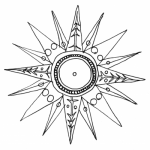IN WHICH DIRECTION?
▶︎A NOTE ON PLUCKING
Plucking angle
Changing the plucking angle can affect sound significantly.
I use the term ‘horizontal’ pizzicato to describe plucking the string left-right across the cello body and ‘vertical’ pizzicato to describe plucking the string perpendicular to the cello body (towards/away from it).
It is possible that horizontal pizzicati are louder and decay faster than vertical pizzicati, and, at angles between these, the output is mixed. These differences are more perceivable in loud dynamics.
In addition, a soft, deep thudding sound is present in horizontal pizzicato.
Rolling the string in a rounded movement while plucking might also increase the duration of the sound.
The string is plucked horizontally, vertically and then with a rolled movement. For the vertical pizzicato, I push the string down rather than pulling it up to avoid a snap pizzicato.
▷IN CONTEXT
Some initial recordings that I have made seem to suggest that this proposition holds. The theory has been adapted from research into guitar acoustics, where the opposite direction of the bridge’s movement means that the effects are opposite to those experienced in the cello: strumming increases duration at the expense of loudness and picking has the opposite effect.
▶︎A NOTE ON BOWING
Vertical Bowing
Vertical bowing is moving the bow directly towards/away from the bridge and nut, in parallel with the string. The string does not vibrate in the usual way. Various sounds are producible, depending particularly on the bowing object and bow pressure. At very light bow pressures the noise of the bow/object rubbing against the strings is heard. For soft bowing objects, such as the bow hair or fingertips, this is a faint and breathy high-pitched sound. Denser bowing objects such as the fingernails or bow stick produce a coarser and louder sound with a lower pitch. Volume increases with the speed (not the pressure) of the stroke.
The hand, the fingernail and a wooden ruler are used to ‘bow’/stroke the string vertically. Crescendi are executed by increasing speed and not pressure.
As bow pressure increases, the sound becomes slightly louder and less consistent. High, irregular squeaks are occasionally present; this is longitudinal vibration of the string. These longitudinal vibrations can be encouraged by rotating the bowing angle (by ninety degrees) so that the bow is (as far as possible) parallel to the string and moving up/down along the string
The string is bowed vertically producing longitudinal vibration (high-pitched squeaks)
Vertical bowing to generate vibration of the bow hair
For fairly low bow pressures and very particular bow speeds (steady and fairly fast), it is possible to generate a very clear pitch by vertical bowing. This is the vibration of the bow hair. This is the opposite situation to a ‘normal’ bow stroke; the string excites vibration in the bow hair, even though it is the bow that is moving. The length and the tension of the bow hair determine the pitch of the tone.
The pitch is raised by:
-Shortening the bow hair by gripping the bow hair between the fingertips (or placing the thumb firmly on the hair)
-Tightening the bow hair (there is only a small margin of flexibility in altering the tension of the bow hair in this way; the technique is more difficult to produce with slack or over tight bow hairs)
Using pressure and speed to change the sound
In general, for low bow speeds, the sound is a series of ‘clicks’ and for high bow speeds it is smoother. For very slow bow speeds and high pressures, a nageln-type effect is possible. For high bow pressure, there is a noisy, ‘rough’ element to the timbre. The sound is easier to control fairly, but not very, close to the frog.
Clicks are produced by bowing at low speeds with medium pressure. At high pressure, nagel-type clicks are produced. Under very high pressure, the string is also forced to vibrate. At low pressures, smoother sounds are produced, then, as pressure increases, the bow hair vibrates.
Diagonal/Circular/Square bowing
The sounds of the vibrating bow hair, the vibrating string and rubbing noises can be mixed by drawing the bow in a diagonal, square or circular motion.
Diagonal, square and circular bowing at gradually increasing pressures: firstly on an open string and then a string damped with the left-hand palm. For the open string, I sometimes hold the bow with both hands to help control its movement, especially for high-pressure bowing.

